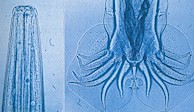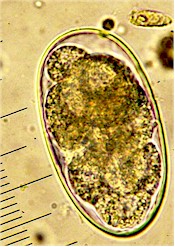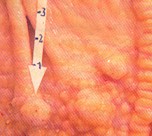Hyostrongylus rubidus, the red stomach worm of pigs, is a roundworm species that affects swine and wild boars. Sows in herds kept outdoors are especially at risk. They are found worldwide, but incidence varies strongly depending on the region. Surveys in certain countries have shown up to 30% of the animals in a herd to be infected.

Very occasionally it can infect calves, sheep and rabbits. Neither dogs nor cats are affected.
The disease caused by this worm is called hyostrongylosis.
Infections with Hyostrongylus are often mixed with other gastrointestinal worms (e.g. Globocephalus, Mecistocirrus, Oesophagostomum, Trichostrongylus, etc.) and contribute to increase the harm caused to the pig herds.
Are pigs infected with Hyostrongylus rubidus contagious for humans?
- NO. The reason is that these worms are not human parasites.
You can find additional information in this site on the general biology of parasitic worms and/or roundworms.
Final location of Hyostrongylus rubidus
Predilection site of adult Hyostrongylus rubidus is the stomach.
Anatomy of Hyostrongylus rubidus

Adult Hyostrongylus rubidus are rather small worms, usually not longer than 10 mm, and have a reddish color because they suck blood. Females are slightly longer than males.
As other roundworms the body of these worms is covered with a cuticle, which is flexible but rather tough. The worms have no external signs of segmentation.
They have a tubular digestive system with two openings. They also have a nervous system but no excretory organs and no circulatory system, i.e. neither a heart nor blood vessels. Males have two spicules for attaching to the female during copulation.
The eggs are ovoid, ~35x65 micrometers, with a thin membrane, and are embryonated (16 or more cells) when shed with the feces.
Life cycle of Hyostrongylus rubidus
Hyostrongylus rubidus has a direct life cycle. After shedding, the eggs release the larvae in the environment, which develop to infective L3-larvae in about 5 days, better outdoors in humid pastures, than indoors. They are not very resistant to dryness and cool temperatures.
Pigs of any age become infected after ingesting such larvae, but piglets are usually more exposed and susceptible. After ingestion, the larvae burrow in the stomach mucosa and produce nodules where they complete development to adult worms. Afterwards they return to the stomach lumen, mate and start producing eggs. Adult worms
After repeated infections the sows develop an incomplete immunity, which causes the immature larvae in the nodules to enter hypobiosis, i.e. they arrest development to adults. This can also happen in periods of adverse environmental conditions (winter, dryness, etc.). They resume development and mature to adults during gestation or lactation. This means that egg-shedding peaks during lactation and consequently lactating piglets are more at risk of becoming infected. Healthy sows usually recover spontaneously after lactation.
The time between infecton and first eggs shed (prepatent period) is about 3 weeks.
Harm caused by Hyostrongylus rubidus, symptoms and diagnosis

This worm affects mainly pigs kept outdoors. Infections in adult pigs are usually sub-chronic and cause light or no symptoms at all, appart from reduced weight gains and poor feed utilization. Nevertheless, larvae in the nodules destroy glandular tissue in the stomach wall.
Adult worms suck blood and irritate the stomach wall, which can cause catarrhal gastritis with excessive secretion of mucus, sometimes with ulceration. Massive infections can be fatal for young animals. Loss of appetite, anemia and diarrhea can also occur.
Diagnosis is confirmed by detecting typical strongylid eggs in the feces. Since the eggs are very similar to those of other pig roundworms (e.g. Oesophagostomum), fecal cultures that allow L3-larvae to develop are advisable.
Post-mortem examination of the stomach reveals nodules in the mucosa and free adult worms visible by the naked eye.
Prevention and control of Hyostrongylus rubidus
Systematic and thorough removal of all manure and keeping the facilities dry reduces the risk of infection. Since development of eggs to infective L3-larvae takes at least 5 days, removing all manure in shorter intervals can break the life cycle and reduce the infectivity of the environment.
Numerous anthelmintics are effective against adult worms, e.g. several benzimidazoles (albendazole, fenbendazole, flubendazole, mebendazole, oxfendazole, etc.), levamisole, as well as several macrocyclic lactones (e.g. abamectin, doramectin, ivermectin, moxidectin), the latter are usually also effective against arrested larvae.
Depending on the country. most of these anthelmintics are available for oral administration as feed additives or drenches. Levamisole and most macrocyclic lactones are usually also available as injectables.
There are so far no true vaccines against Hyostrongylus rubidus. To learn more about vaccines against parasites of livestock and pets click here.
Biological control of Hyostrongylus rubidus (i.e. using its natural enemies) is so far not feasible. Learn more about biological control of worms.
You may be interested in an article in this site on medicinal plants against external and internal parasites.
Resistance of Hyostrongylus rubidus to anthelmintics
So far there are no reports on resistance of Hyostrongylus rubidus to anthelmintics.
This means that if an anthelmintic fails to achieve the expected efficacy, chance is very high that either the product was unsuited for the control of Hyostrongylus worms, or it was used incorrectly.
Learn more about parasite resistance and how it develops.
|
Ask your veterinary doctor! If available, follow more specific national or regional recommendations for Hyostrongylus rubidus control. |